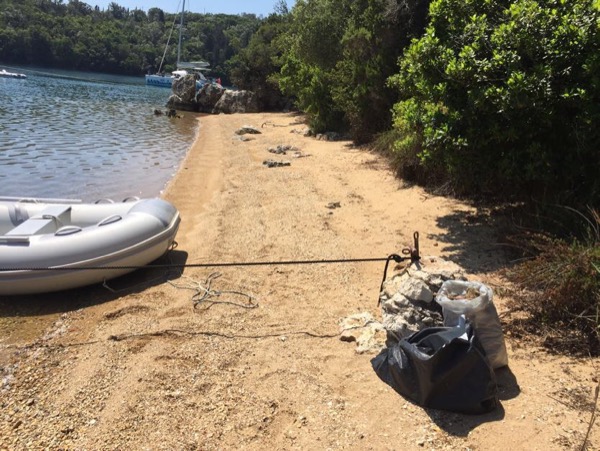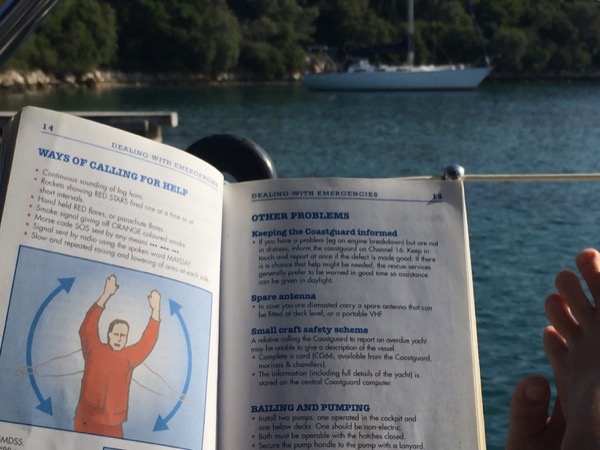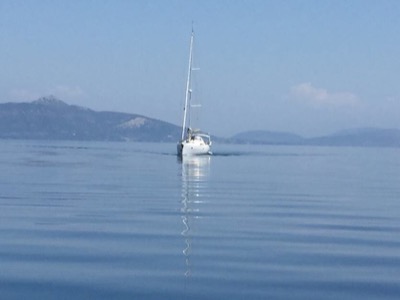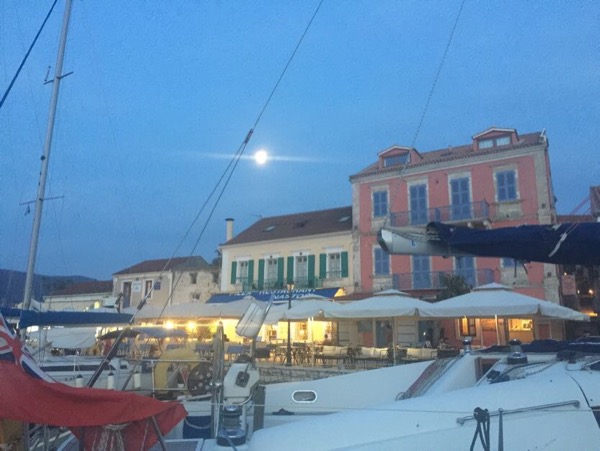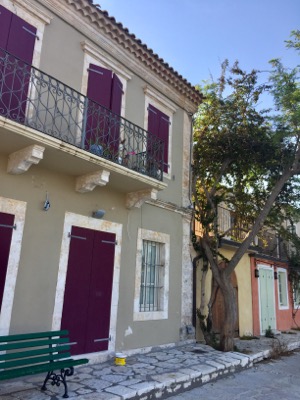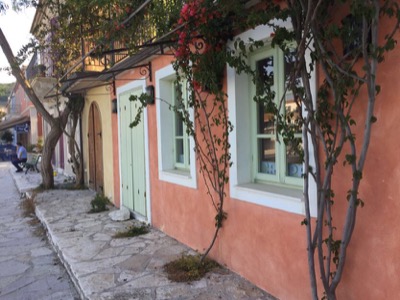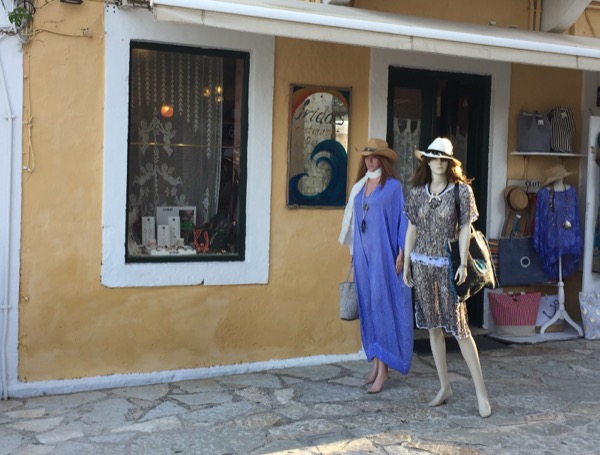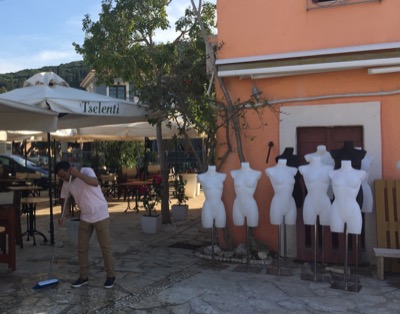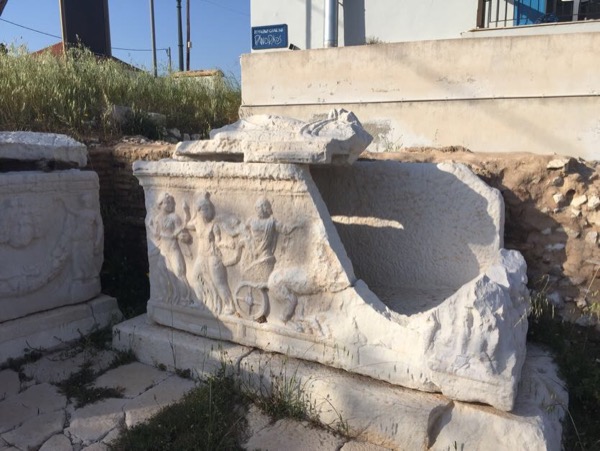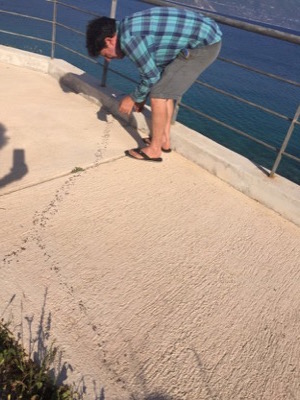Fiscardo
26th - 30th April
From Nidri we chugged on becalmed seas back to Abeliki Bay on the island of Meganisi to a peaceful anchorage by a small beach with lines ashore.
Greece is remarkably full of litter. The bins overflow and nobody really seems to care, bits of rubbish are part of the picture it seems. I realised today I have come to feel in some way it is part of the charm of Greece, the way it isn't too orderly and has a manageable amount of random chaos. But the self indulgence that a yacht represents leaves me feeling I should try to do something to compensate mother earth. Perhaps we could leave a trail of picked plastic litter behind. With the emerging popularity of 'plogging' - picking litter whilst jogging - perhaps there is scope to develop the idea of plyachting. Or perhaps plotting, for ease of pronunciation? Or maybe ploating...?
So anyway I have posted the photo above on the 'Friends of Levkas Marina' Facebook page and have had 22 likes. I may have started a movement.
Whilst I was busy (all of ten minutes) plyachting, Paul picked up a bug instead and was rather out of sorts for a few days. This prompted me to start reading the books on board about sailing. Including how to respond in an emergency, should the sore throat prove life threatening and render me in sole charge.
The crossing south to Kephalonia however was uneventful. A becalmed day at sea with no call for help, medical or otherwise, required on this occasion.
Approaching the north of the island of Kephalonia we found a spot on the quay in the small village of Fiscardo with colourful houses lining the quay.
The historical events described in Captain Corelli's Mandolin took place in this area and the book has captured the charm of the island. It feels strange somehow how a place so benevolent with its sleepy streets, sunlit coves and creeks and olive groves, has been the scene of such terrible events. These islands never got off lightly. After the second world war there was the devastating 1953 earthquake. After this the majority of the island's population emigrated to countries such as Canada, USA or the UK, leaving both the islands and their economy in ruins.
The earthquake raised the whole island of Kephalonia an astonishing 60cm. Fiscardo was the only settlement on the island which was not completely destroyed. Because it did not need rebuilding the original layout remains, with streets that can only accommodate a horse and cart. The absence of cars and asphalt along the quay retains a sense of the original fishing village in spite of the end to end line of attractive restaurants and cafes and shops selling wafty garments.
I am quite taken with Greek mannequins. They have a certain something, a hint of Hitchcock...
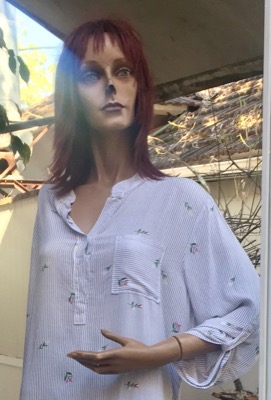
A charming shop assistant persuaded me to try to emulate the look but without the broken nose or the arrested eyes perhaps it does not have quite the same effect.

It feels like we are on the cusp of something here. Everywhere shop fronts are being painted, furniture is being installed, things are being cleaned, mannequins are being dressed for the season.
The place is being readied for the onslaught.. We are feeling lucky to be here before the crowds, and be able to enjoy dining in style straight off our gangplank. Part of Fiscardo's attraction is that it is also a very safe harbour, with an old Venetian lighthouse a 20 minute walk through a pine-clad headland. As one of the western-most points of Greece, it is popular with Italian yachts and is apparently chaotic in the height of the season. Even at this early stage of the season we were involved in a fair amount of chaos, moored as we were in a part of the quay known as 'Crossed Chains Corner' as we later found out. The water in the harbour was so clear that we could track the chains from all the boats from our dinghy and see whose chains were involved and how. Five chains crossed ours but fortunately they all arrived after us, so all we had to do was witness the shenanigans as they departed, hooking and disentangling themselves from a number of other anchors in the process. One boat had hooked the chain of a ferry (which we had missed by 30cm..) and the skipper swam down 9 meters to unhook it by pulling himself down on his own anchor chain.
The great benefit of not doing any research or pre-planning is the element of surprise it confers. Walking around Fiscardo we stumbled across a Roman graveyard with a cist with a carved relief of Athene and Aphrodite chasing Hades. The past comes alive in a different way when it is so unceremoniously there in front of you, rather than behind bars in a museum.
I am enjoying the wildlife, the fish, the birds - and now also the ants. They had a very efficient operation going in the Roman graveyard, foraging for architectural resources for their underground city. Here Paul is carrying out a field experiment to measure levels of strength and motivation in the Greek ant.
Fiscardo has a number of marked footpaths and whilst following 'the cypress path' we heard a gathering chorus of bells and windchimes apparently coming from the wooded hill the other side of the bay we were heading for. We know that there are yoga retreats around here and the sound brought to mind some kind of hippie gathering. The music grew louder as we approached the bay so it must be near there. When we got to the bay it turned out the origin of the music was very different. See the short video below to find out (with the sound turned up!)
Click HERE
